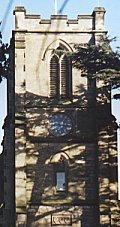Hurworth
 |
|
Hurworth from the Anglo Saxon
"Hurde Wurde" (an enclosure made of hurdles) or in earlier times Hurthworth meaning enclosed settlement
(worth) with a wickerwork hurdle or hedge (Hurth).
wooded hill?, extends along the northern edge of the River Tees, overlooking a large natural ampitheatre of about
four miles in circumference to the south.
Steps and a narrow lane leading down to the river edge at the east end of the village, opposite the Otter and Fish
are all that remains of the ferry landing site which operated until 1906.
|
| |
|
|
|
|
| Flax |
|
Behind the Otter and Fish in Strait Lane is a row
of terraced cottages with upstairs windows placed very close to the eaves. These are old weavers cottages and were
designed to maximise the amount of light entering the upper floor where workers operated their spinning machines.
Stem fibre from locally grown flax was spun into thread and then into linen cloth. At it's peak in 1830, 120 weavers
were employed in Hurworth, until weaving ceased in 1870.
Fields of blue flowers are becoming much more common as farmers are converting to growing flax. |
|

|
| |
|
Linseed oil derived the seeds is used in the manufacture
of putty, paints, fine varnishes and lino or linoleum - a traditional floor covering. More recently, linseed oil
has been used to extend the durability of concrete. The residue from processed flax
and seeds was used as animal feed, but flax is now gaining in popularity as a nutritious food source for humans
with its essential fats and soluble fibre. |
| |
|
|
|
|
William Emerson (1701 - 1782).
 |
|
William Emerson, who was born and lived in Hurworth,
wrote a number of influential books on math's, geometry, navigation and optics, together with a series of manuals
for beginners in mathematics. He turned down an invitation to become a member of the Royal Society, because he
objected to paying for the honour of FRS after his name.
Some of the older buildings in the village have sundials designed by him. All of the clocks show the line of latitude
in addition to the time. The Emerson Arms with its beer garden and superb views over the river, bears his portrait,
possibly in recognition of his fondness for ale and fishing. His tomb and the grave of his lifelong friend and
pupil, John Hunter stand in the churchyard of All Saints. |
| |
|
|
|
|
All Saints Church.
 |
|
Founded in the late 12th-century with chancel, nave,
aisles, a porch and a low west tower, the church has been restored and extended a number of times over the centuries.
Little of the original building remains apart from the fine 15th-century tower and medieval piers. During the restoration
of 1831-1832, the church was almost entirely rebuilt with transepts, galleries and 830 seats to cope with a greatly
increased population. Barely, 40 years later, the chancel was enlarged and the galleries removed in another substantial
rebuilding. |
| |
|
|
|
|
Daffodils and Plague.
 |
|
The village green is swathed in daffodils during
the early spring and is the site for both the annual Strawberry Fair, organized by Hurworth Scouts and for the
village Christmas tree.
Most visitors are probably unaware that it is also the burial site of the entire population of the medieval village
of Hurworth, who were wiped out by the bubonic plague. |




